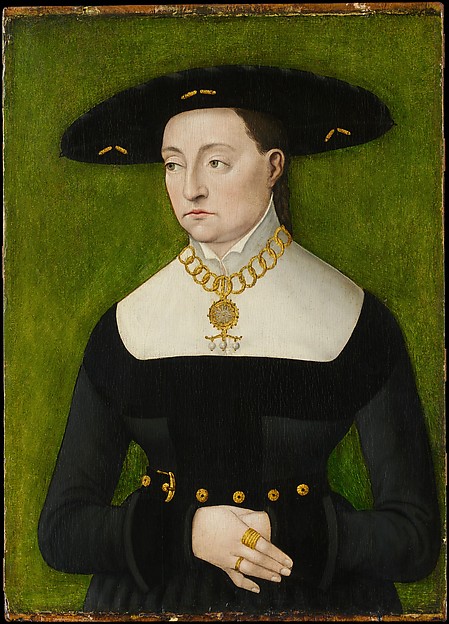1520-luvun harmaa puku ja kaksi ritamusta
A 1520's grey dress and two partlets
Rakastavaisten naisen pukukokonaisuus ei suinkaan ollut aivan ensimmäinen saksalaistyylinen renessanssipukuni. Sitä ennen olin tehnyt eräänlaisena harjoitusversiona alempaa löytyvään maalaukseen perustuvan hameen. Syystä tai toisesta en tullut dokumentoineeksi tätä pukua laisinkaan. Pari päivää sitten päätin vihdoin kuvauttaa sen. Ikävä kyllä, ne kuvat eivät onnistuneet sääolosuhteiden vuoksi kovinkaan hyvin, joten yritimme tänään uudelleen paremmalla onnella.
The Lovers dress was by no means my first dress in the style of the German renaissance. Before it, I had made a kind of a trial dress based on the painting further below. For one reason or another, I never got around to documenting this one. A few days ago I finally decided to photograph it. Unfortunately those pictures did not turn out too well, so we thought to try again today and with better luck.
Harmaa puku on ohutta villatoimikasta ja se on reunustettu mustalla villapalttinalla. Ja kyllä, kaikki on ommeltu käsin. Ehkä sen huomaa, mutta en oikein pidä ompelukoneista....
The grey dress is made of grey wool twill and it's edged with black plain woven wool fabric. And yes, everything is sewn by hand. I guess my aversion to sewing machine is showing...
Puvun liivimäinen yläosa on leikattu kahdesta etukappaleesta ja yhdestä takakappaleesta.
The vest-like bodice consists of two front pieces and of one back piece.
Liivi sulkeutuu edestä hakasin. Puvun yläosa on vuorattu kahdella erilaatuisella pellavalla.
The bodice closes with hooks and eyes. The upper part of the dress is lined with two different types of linen.
Hame on leikattu 1500-luvun lopun itävaltalaisten räätälinkirjojen ohjeiden mukaan yhteensä neljästä osasta: kahdesta etu- ja takakappaleesta. Helman leveys on n. 500 cm. Hameen vuori on mustaa pellavaa / pellavasekoitetta.
The skirt is cut in four pieces after the examples is late 16th century Austrian tailor's books, with two front and two back pieces. The hem circumference is c. 500 cm. It's lined with black linen / linen blend.
Uusien projektien yhteydessä on myös mukava kokeilla erilaisia tekniikoita. Tämän projektin kohdalla kokeilin nk. topattua helmaa. Harmaan hameen helma on käännetty vinoon langansuuntaan leikatulla mustalla villakankaalla, jonka sisältä löytyy ohut pellavakaistale. Tekniikkaan voi tutustua täällä.
I like to experiment with new construction techniques every time I make something new. The new thing with this one, is the so called padded hem. The hem is turned wit the bias cut black wool and padded with strip of linen. You can read more about the padded hem here.
Puvun innoittajana toimi Hans Brosamerille (k. 1552) attribuoitu maalaus. Se esittää myöhempien tietojen mukaan 38-vuotiasta Katharina Meriania. Naisen asukokonaisuuden ja asusteiden tyyli viittaa 1520-luvun Nurembergiin. Lisää tietoja maalauksesta löytyy täältä.
The grey dress is inspired by a painting attributed to Hans Brosamer (d. 1552). A later inscription tells that it is a portrait of a Katharina Merina, aged 38. Her dress and accessories point to 1520's Nuremberg. More information on the painting can be found here.
 | |
| The Met |
Rintamuksen
brokadikangas on halpaa keinokuitua ja vuorattu viininpunaisella paksulla villatoimikkaalla. Suoraan sanottuna sen kuvio ei
ole aivan oikeaoppinen: se muistuttaa viktoriaanisia sisustuskankaita,
jotka tosin saivat innoituksensa renessanssista. Koska kyseessä oli harjoituskappale, en ajatellut laittavani rahaa alkuperäisiä kankaita jäljittelviin damasteihin.
The
partlet is made of a cheap syntethic brocade and lined with thick wine red wool twill. Frankly, the pattern is
not completely authentic: it reminds me of the victorian fabrics used in
soft furnishings that got their inspirations from the renaissance. Yet,
since this was a trial piece, I was not prepared to splurge on
reproduction damasks.
Rintamuksen innoitajana toiminut muotokuva löytyy esimerkiksi täältä.
The inspiration for the partlet came from this portrait.
Alla oleva valkoinen rintamus on ommeltu kaksinkertaisesta ohuesta pellavasta ja suljettu neuloilla.
The white partlet underneath is sewn from two layers of thin linen and closed with pins.
Mistä huomaa, että hunnun alla oleva wulsthaube ei ole aivan valmis....?
Can you tell that the wulsthaube underneath the veil is not finished...?
Kaiken kaikkiaan puku ei kuitenkaan ole hassumpi. Ehkäpä sille löytyy vielä käyttöä ;-)
All in all it's quite nice for a first try. Perhaps I'll find some use for it ;-)












Erinomaisen hieno puku ja kirjoitus, ainoastaan: Nurembergin oikea suomalainen (ja saksalainen) nimi on Nürnberg.
ReplyDelete